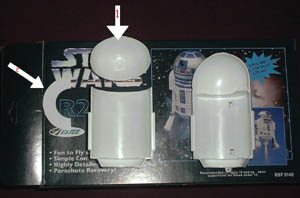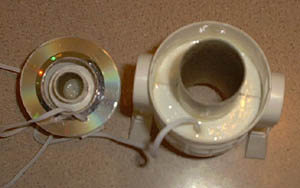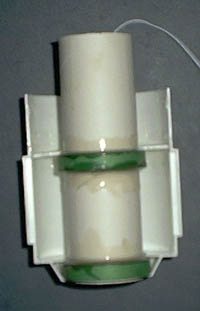Estes Star Wars R2-D2(2) Modification
Modification - Star Wars R2-D2(2) {Modification}
Contributed by Ken Johnson
| Manufacturer: | Modification |
Brief:
Another in the continuing series of improved "little" R2-D2 rockets from Estes. This one features what the "big" R2 had all along: A REAL nose cone, thereby eliminating recovery failure.
Modifications:
The first thing that had to go was the top, so R2 was beheaded at the blue band, just below the reinforced bulkhead. This bulkhead was then lowered about an inch and reattached to the inside of the body using CA, then reinforced on both sides with 2 hour epoxy. The shock cord attaches here. (Question: why is Estes so stingy with shock cord on all other rockets, but gives out 3 times what is needed with the little R2?).
(Question: why is Estes so stingy with shock cord on all other rockets, but gives out 3 times what is needed with the little R2?).
The thrust rings were attached to the inner tube, and the whole thing was slathered liberally with 5 minute epoxy. Strength was my goal, and weight considerations were not a concern. I think I met those goals.
Attachment of the head was a real challenge. Since the head had no shoulder to attach to the body like a real nose cone, I chose to cut up one of the 3000 or so AOL CDs I get in the mail each year. Perfect. It was attached to the bottom of the head with CA, then epoxy, and the shock cord attaches here. To keep things straight, and to give me a place to put nose weight, I attached to plastic centering rings for the original motor pod to the head. This was done by using a short piece of 18mm tube, then was centered into the head by a process that was far more complicated than anything I've ever done on a mid-power rocket. Naturally, 5 minute epoxy holds it all in place, and it leaves a nice little hole in the center so I can adjust the nose weight. All the paper items were soaked in CA for a little strength, and unfortunately the fumes attacked one of my eyes. Please use proper safety equipment if you use CA!
then was centered into the head by a process that was far more complicated than anything I've ever done on a mid-power rocket. Naturally, 5 minute epoxy holds it all in place, and it leaves a nice little hole in the center so I can adjust the nose weight. All the paper items were soaked in CA for a little strength, and unfortunately the fumes attacked one of my eyes. Please use proper safety equipment if you use CA!
I will from now on. Believe me, it took a LOT of engineering to get the rocket this far. But it was all worth it. The fins were recycled from R2-D2.3, and was about all that was salvageable. A nice nylon parachute guarantees a shred proof recovery, but fit is TIGHT.
Construction:
A basic R2-D2 kit from Estes can be had for really cheap these days; I bought a half dozen off eBay for less than the price of a cheap mid-power rocket. Why? Well, I love these little things, but the factory recovery system left a lot to be desired. And I've tried several methods to improve upon the ill-fated design Estes had, including Kevlar®, elastic, and tubular nylon. Nothing worked reliably. And the second reason I did it is because I just love to overpower Estes and Quest rockets.
Why? Well, I love these little things, but the factory recovery system left a lot to be desired. And I've tried several methods to improve upon the ill-fated design Estes had, including Kevlar®, elastic, and tubular nylon. Nothing worked reliably. And the second reason I did it is because I just love to overpower Estes and Quest rockets.
So, I decided right from the start that R2-D2 (designated R2-D2.4) would have a real nose cone like its big brother. And since I was at it, why not a 29mm mini R2? After all, R2-D2.3 was 24mm, and worked extremely well. (Unfortunately, it met its demise at the hand of one of Aerotech's famous bonus delays)
The original kit was a real quality piece, and was one of the few I received without warped fins. These fins will be used on my son Josh's R2. I haven't finished this rocket, but plan on painting it all flat white with bumper chrome head and painted on decals. Everything fit wonderfully, but took far more work than I anticipated. The results don't reflect this, but it was definitely a challenge. And that was most of the reason I built it. I love engineering challenges. (That's why I don't use RocSim).
Flight:
As I stated in the beginning, I built this rocket with 29mm in mind, and thus was reinforced for use with a single use G80. However, the short, squat body has extremely short polar moments, and for safety reasons I decided to cut down the power. After all, who wants their 5 year old to be chased around the launch site by a screaming R2? If it went unstable, it might get nasty. As it turns out, a D will get it going reasonably well, and a long burn E6 should satisfy anybody's quest for altitude. So a 24mm motor tube was put in place, with a paper engine block in the top of the motor tube. (Past experience with R2-D12 showed me that the stock Estes retaining clip will not hold up to E power for long.)
FLIGHT: With a D12-5, the little R2 will get up with decent speed, and hit approximately 500 to 600 feet, depending on which spotter's info you use. Recovery is perfect. Prep is a breeze, use a little cellulose wadding (not really necessary, but I like to feel safe) and friction fit the motor. Wrap up the lengthy shock cord and stuff it into the tube on top of the chute. Then pop on the head.
On an E15-7W, I have no idea how high it goes, because it's hard to see at that altitude. But the launch is worth it all. People look at the rocket with disdain when it is announced, and it looks tiny out there on the pad. Some scoff about the reported motor size, but when the motor roars to life and R2 becomes a blur instantly, jaws drop open. And that's what I like about it.
Summary:
Pros: Attention getter, rapid take-off, perfect recovery.
CONS: Took too long to build, hard to spot, very sensitive to wind, fly only on calm days.
#Related Reviews
Related Products
 |
 |
 |
 |
Ken Johnson (June 4, 2015)
Rest In Peace. Or pieces; the ejection charge blew it to smithereens when it came down a little fast. Will not rebuild.